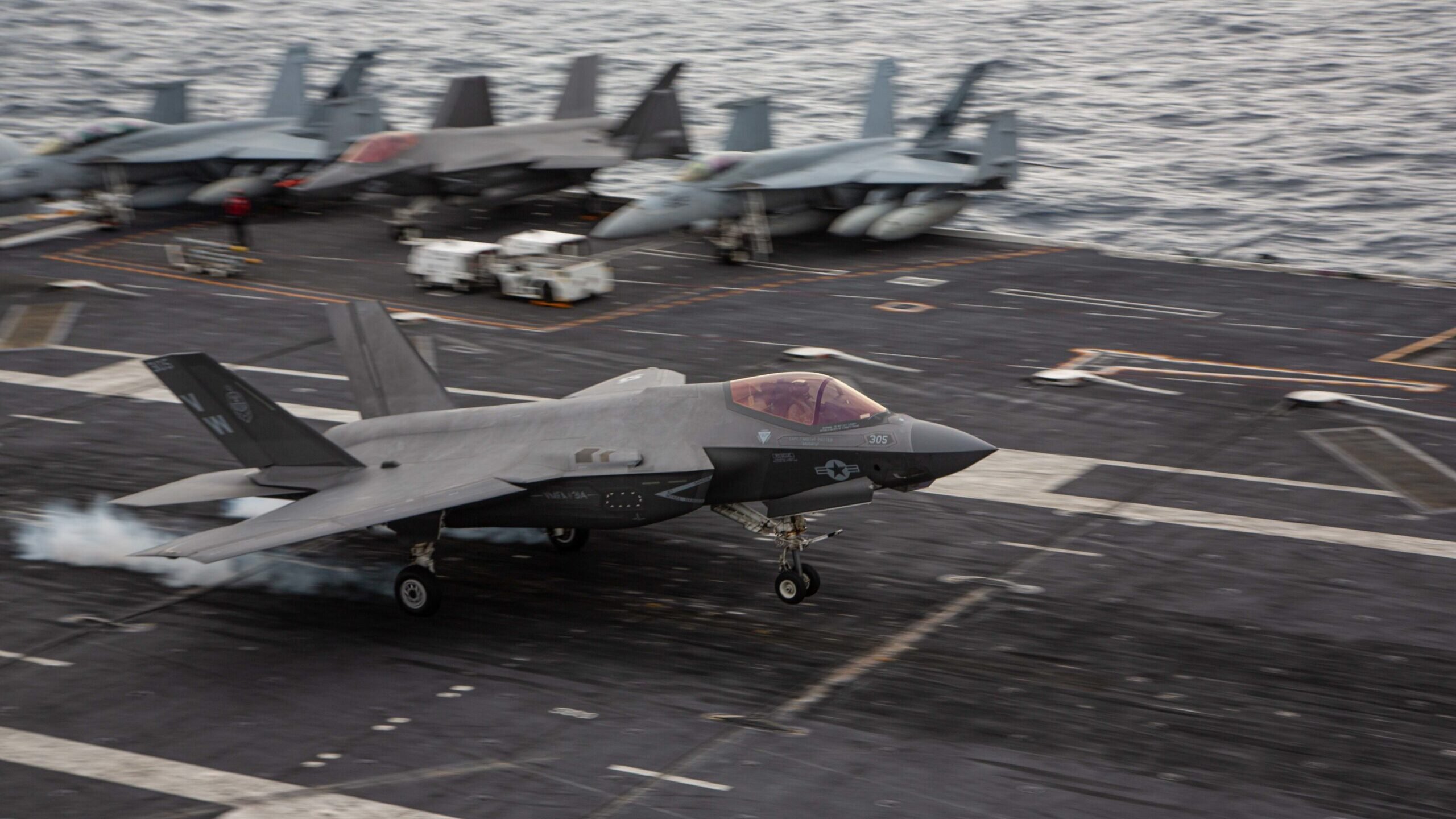
An F-35C, assigned to Marine Wing Fighter Attack Squadron (VMFA) 314, launches from the flight deck of the aircraft carrier USS Abraham Lincoln (CVN 72). (US Marine Corps/1stLt. Charles Allen)
PARIS AIRSHOW — As the F-35 program approaches a two-pronged effort to modernize both its engine and Power and Thermal Management System (PTMS), Raytheon Technologies is offering solutions for both problems — a move that, if successful, could supplant Honeywell International as a supplier of a key subsystem for the Joint Strike Fighter.
Since the two solutions were unveiled by Raytheon through its respective subsidiaries of Pratt & Whitney and Collins Aerospace in December 2022, Pratt’s Engine Core Upgrade (ECU), an enhancement of the company’s current F135 engine, has dominated modernization discussions for the F-35. But with fresh scrutiny of the fighter’s PTMS highlighted by recent watchdog reports, Collins’ offering to upgrade the cooling apparatus — dubbed the Enhanced Power and Cooling System (EPACS) — has garnered a new focus.
“We’re looking forward to the opportunity to partner with Lockheed Martin and the [F-35 Joint Program Office, or JPO], if you will, to further refine the solution and minimize the changes to the aircraft,” Henry Brooks, president of Collins’ power & controls division, told reporters about EPACS in a briefing at the Paris Airshow today.
The current PTMS is supplied by Honeywell, which Collins would seemingly have to beat out for an opportunity to provide a new thermal management system for the F-35. According to a Government Accountability Office report from March [PDF], prime contractor Lockheed Martin discovered in 2008 that the PTMS would need more bleed air from the Pratt-made F135 engine than originally planned. As a result, the powerplant is being forced to run hotter, risking the need for more frequent and costly maintenance particularly as the program eyes future upgrades.
RELATED: Upgraded F-35’s won’t be accepted by Pentagon come July
Asked directly whether the company is seeking to replace Honeywell on the PTMS, Brooks replied that the EPACS would be an “agnostic” solution regardless of the engine that powers that fighter. He further stated, “What I can say is that our system will indeed provide two and a half times the cooling that’s on the airplane today. And we believe that the power and thermal management system that’s on the airplane today has reached basically its limit.
“So we’re looking to make sure that we provide solutions that support the F-35 well into the future,” he added. “And we believe that our power and thermal management system” can achieve that.
It’s unclear how the upgrade to the jet’s current PTMS could play out, as the program has so far not announced any competition or sourcing decision for a refreshed system.
“We’ve had several conversations, and we’re in ongoing conversations as far as that part goes. But I’m not prepared today to talk about any bids, proposals, that sort of thing,” Brooks said. “I’ll leave that to JPO and Lockheed Martin to sort that out.”
In a statement to Breaking Defense, Honeywell stated that contracted work is already underway to improve the company’s PTMS.
“Honeywell’s PTMS meets all requirements set forth by Lockheed Martin and has performed in accordance with all required specifications,” the company said. “Additionally, and separate from compliance with current system requirements, Honeywell continues to work in partnership with Lockheed Martin and the Joint Program Office to further upgrade the PTMS to meet anticipated additional, future cooling requirements, and we are currently under contract with Lockheed Martin to significantly increase the cooling provided by PTMS for these advanced mission systems aboard the F-35.”
According to a previous report in Aviation Week, the F-35’s continuous capability development and delivery program has already funded a “minor cooling system upgrade” that Honeywell is readying to deliver for the jet this year.
ECU, EPACS timeline
Jill Albertelli, Pratt’s president of military engines, announced today that the ECU is “on track” to complete preliminary design review early next year, and reiterated the company’s previous position that the upgrade can be fielded by 2028.
Additionally, Brooks said that following a successful lab demonstration, EPACS is expected to reach the Pentagon’s Technology Readiness Level 6 threshold by the end of this year. In a press release today, Collins stated that it anticipates EPACS will “be ready to begin an engineering & manufacturing development program as early as 2024.”
The JPO, for its part, is grouping the PTMS and engine modernization efforts together, and a spokesperson for the office told Breaking Defense in a statement that the dual solution will be fielded in 2030.
“We are treating the ECU and PTMS as a single development program. They must be integrated to ensure we are providing the power and cooling requirements of the Warfighter,” JPO spokesperson Russ Goemaere said. “The modernization effort is expected to be fielded in the early 2030 timeframe to support beyond Block 4 capabilities. We are in the early design phase and the schedule is dependent upon the approved solution that will be developed in coordination with the Services.”
Asked about the timeline for ECU, Albertelli clarified the company’s 2028 projection specifically applies to the ECU, and explained that it would arrive “probably later in [the] 2028 timeframe,” further stating “that’s our target.
“The power and thermal management system upgrade is something that also needs to be looked at,” she added, “and I’m sure looking at them simultaneously is a great thing to do for optimization of design.”








